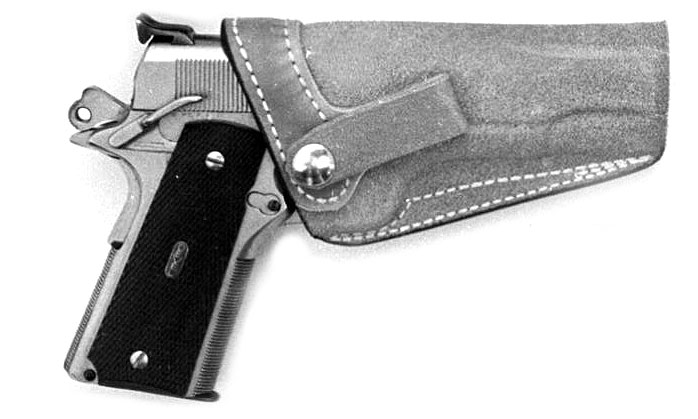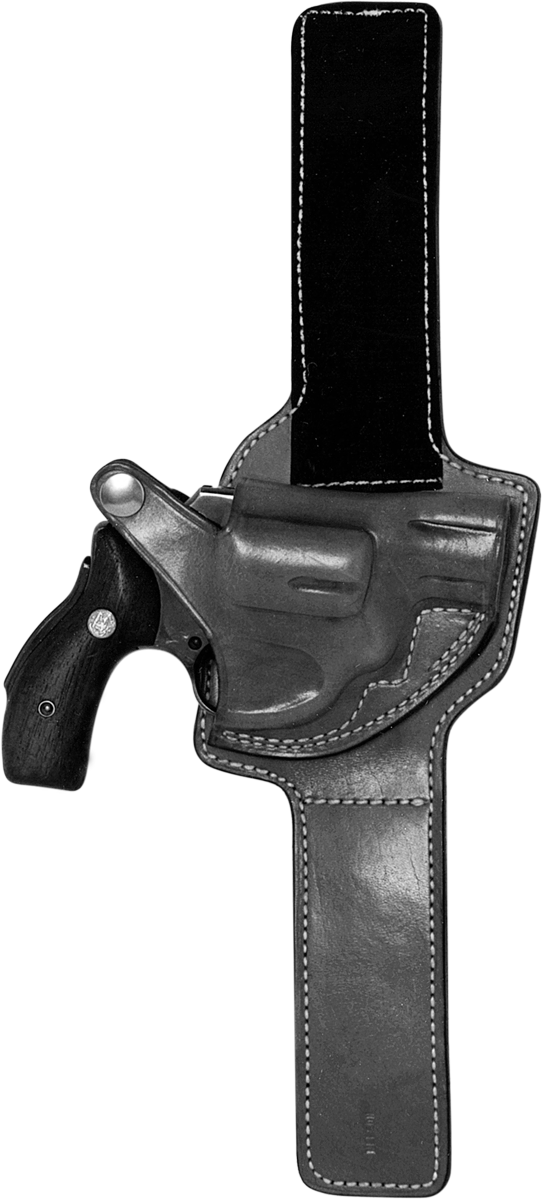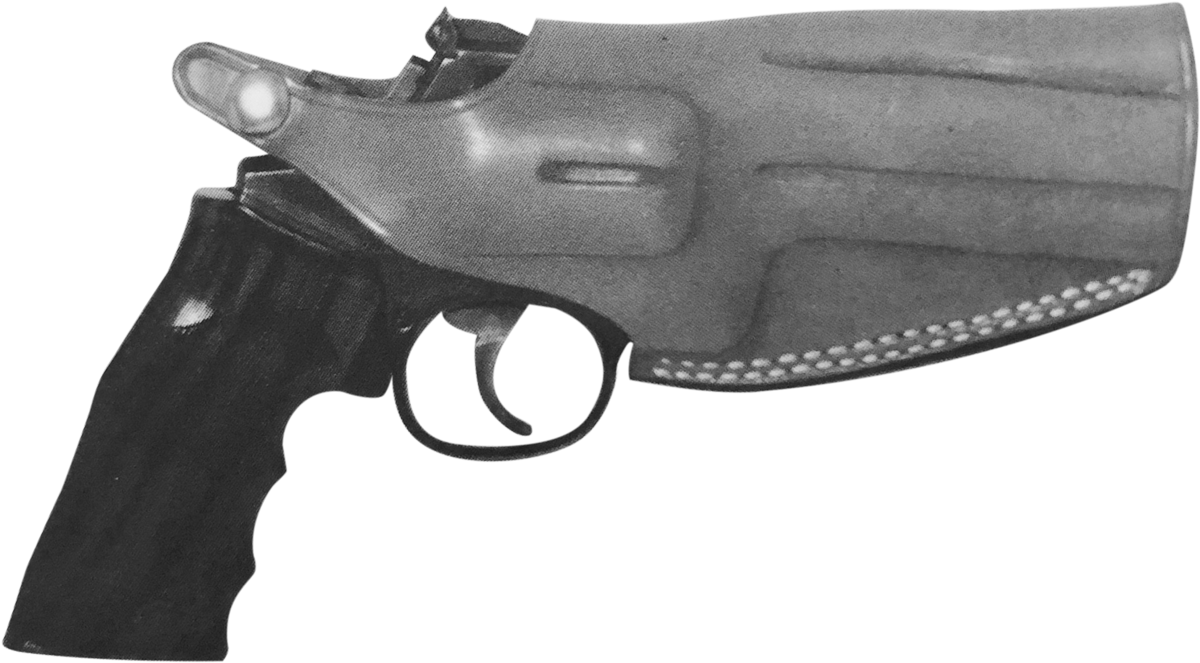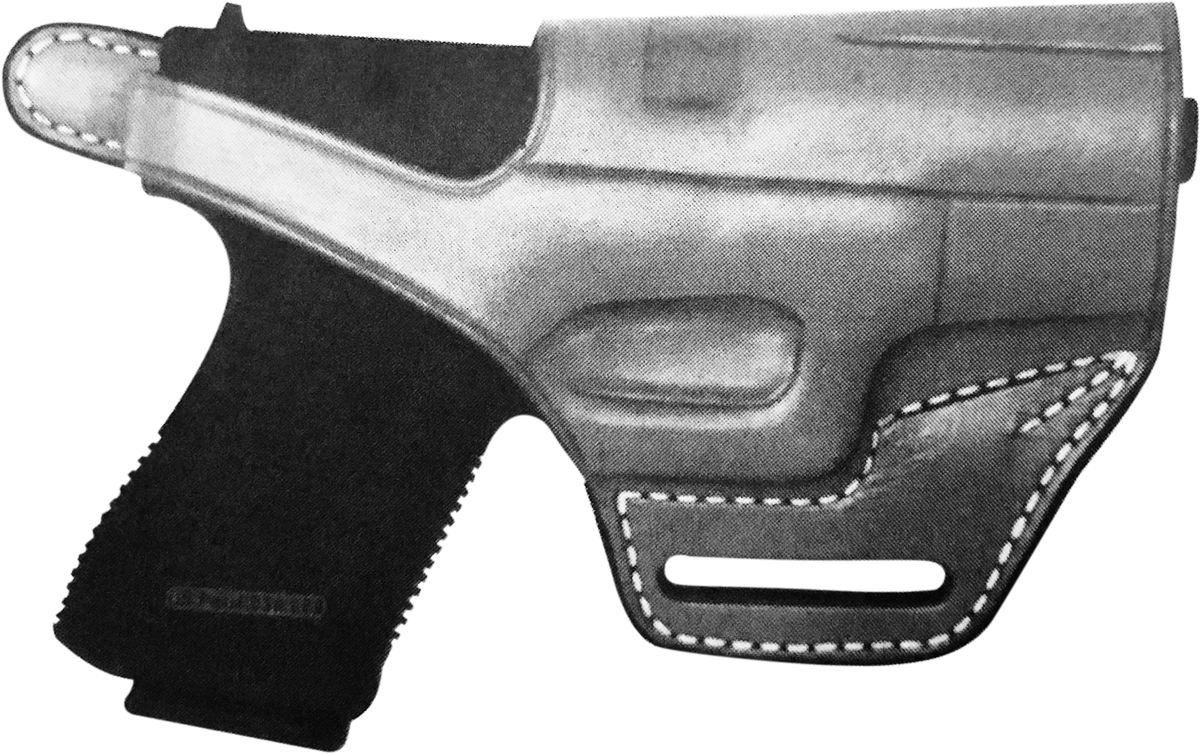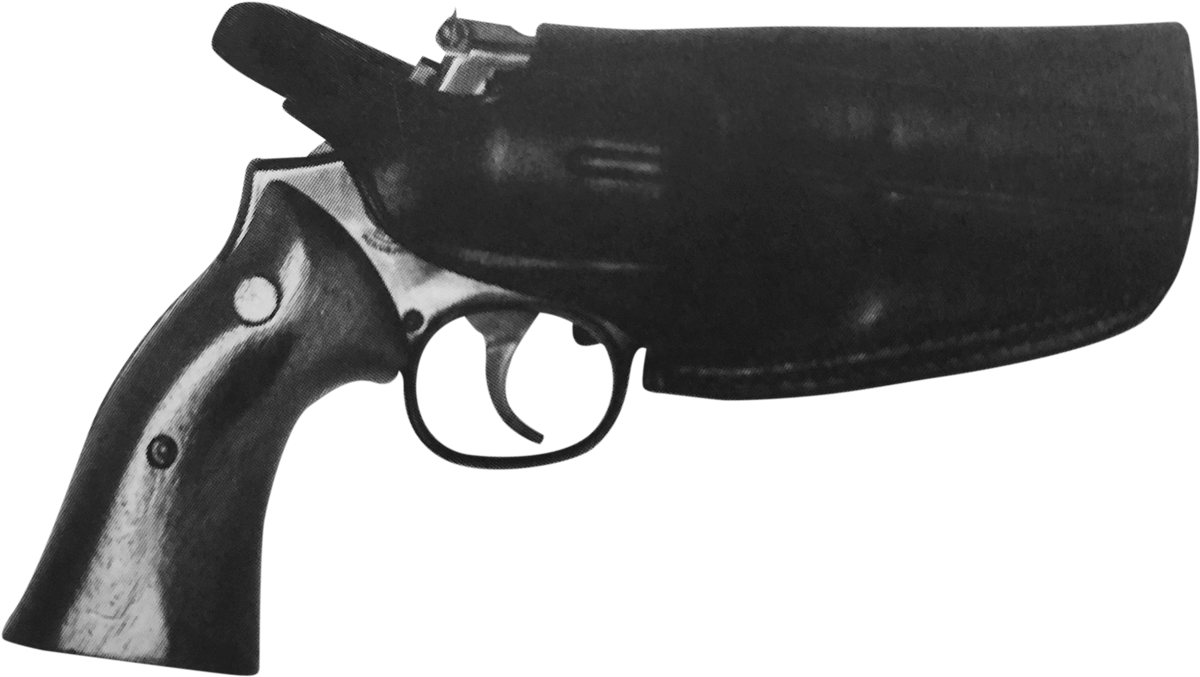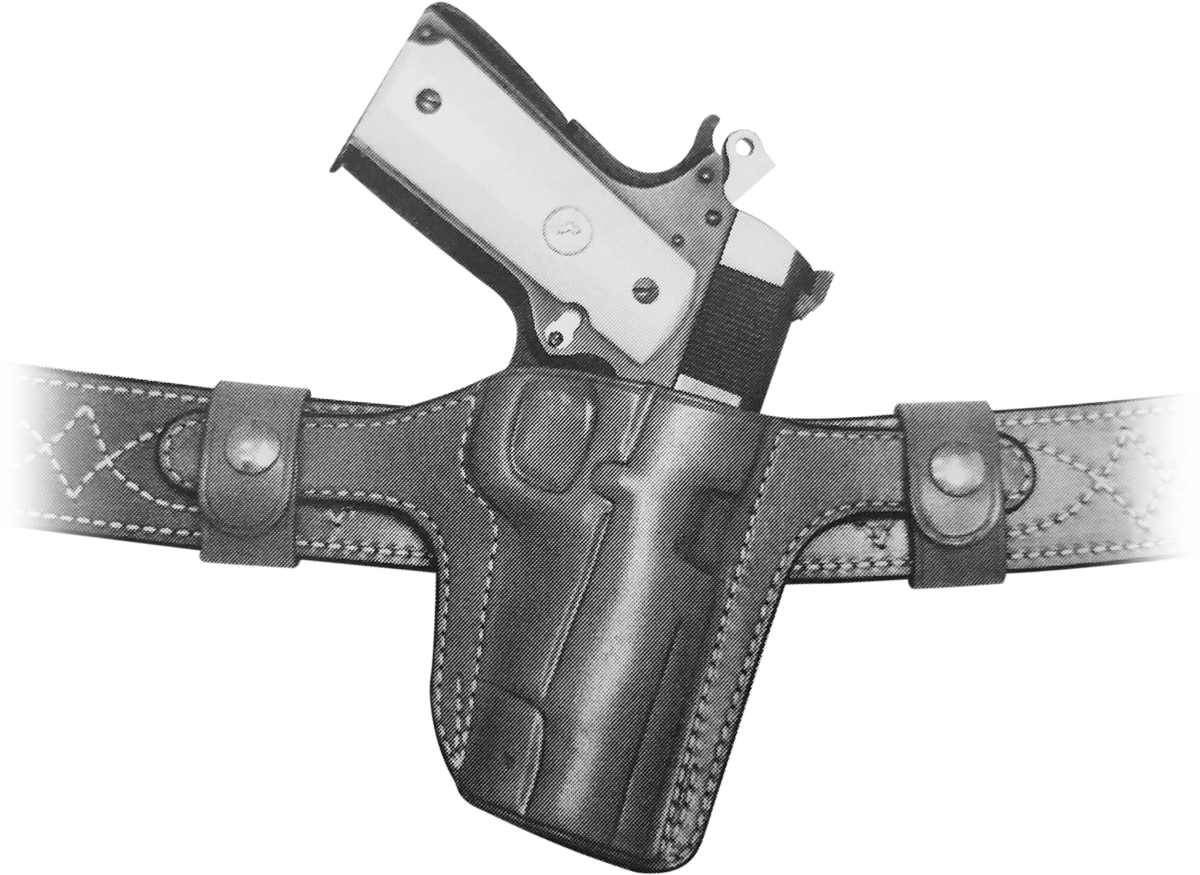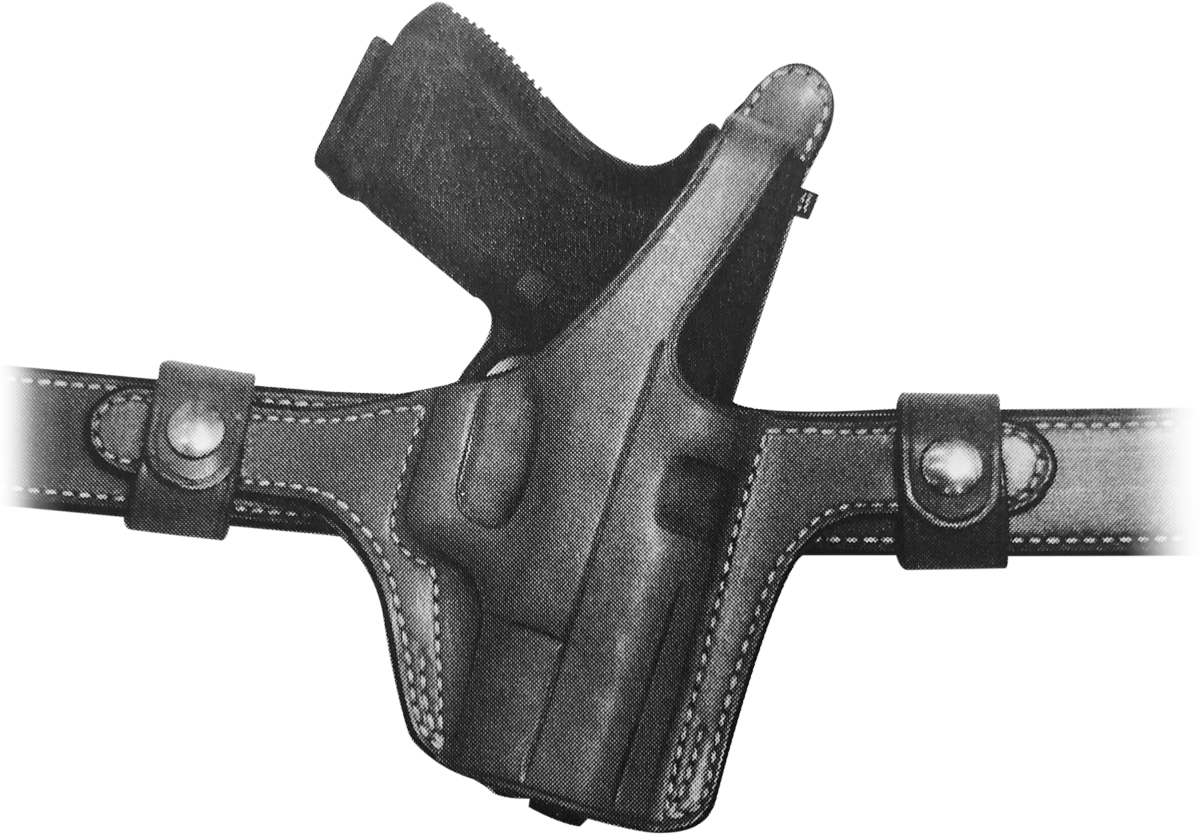
BRUCE NELSON COMBAT LEATHER
As a holster designer and leather craftsman for over 20 years, I
am always surprised at how little useful specific information
holster catalogs contain. I suspect that many companies simply
do not want to be bothered explaining what they sell, while
others don't really have a firm philosophical and technical
basis for the products they offer, preferring instead to imitate
common designs of the past. It is my intention to provide you
with something quite different. Instead of a sales pitch with
standard phrases such as "best materials and workmanship," I
want to give you insight into how a specific design is
formulated and how it relates to the problem it solves. If I
have done this well in the text that follows, you will be able
to look for specific, observable qualities in any leather gear
you are considering for purchase.
It is important to
me that you find what is of most service to you and your special
requirements. Quality can only be judged once you receive your
order, since no photograph or description will adequately convey
what the leather can say for itself. Therefore I would rather
use this catalog to explain holster and carry system design and
function than to give you the same advertising superlatives you
can read anywhere.
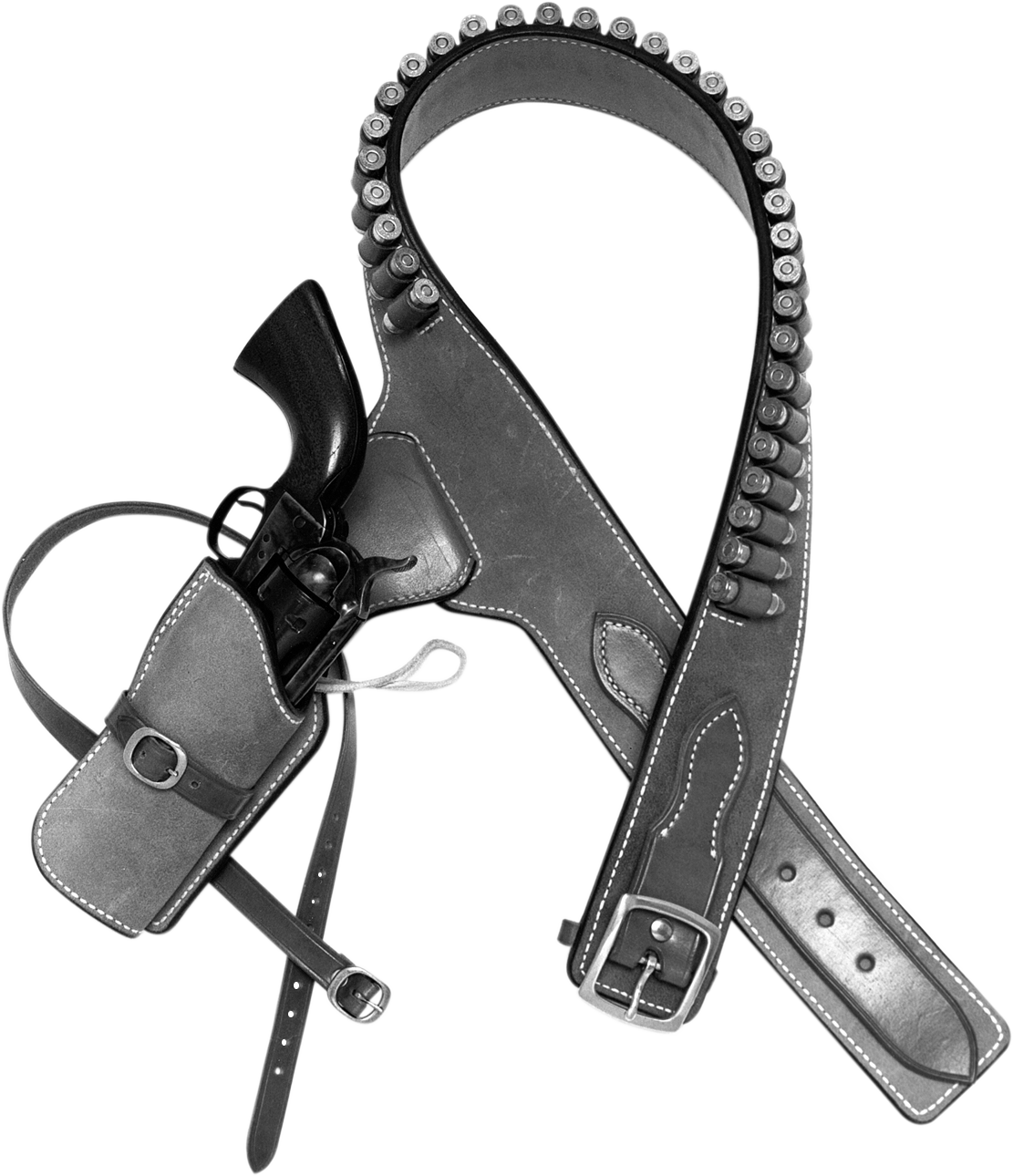
HOLSTERS
In the mid-1960's practical pistol competition was still new,
and the few of us who were involved in those early years learned
many things from testing ourselves and our equipment. The
tradition in holster design was most strong side belt holsters
barrel to the rear as much as 45 degrees. As efforts were made
to increase draw efficiency, and thereby speed, it was apparent
that a consistent firing grip was made more difficult by this
barrel rear angle. Slow motion photography revealed the source
of the problem. Central to a consistent firing grip is the
burying of the web between thumb and index finger into the upper
backstrap of the pistol, especially in the case of the
auto-pistol. This became more difficult the greater the angle.
The limiting factor in this movement is the maximum degree of
rearward wrist angle, which in turn tends to induce a forward
"hunch" movement from the waist up.
#1 Professional - Semi-Auto Pistol
In 1967, I designed the #1 Professional for Semi-Auto Pistol to
correct these problems. This holster is set for straight-drop
angle and therefore eliminates the above problem. It allows for
the forearm/wrist angle to remain constant throughout the draw,
eliminating the need for reestablishment of this angle in the
firing stance.
The issue of concealment has been
credited with necessitating the barrel rear cant. To a certain
degree this has been true due to the limitations imposed by the
traditional single fold over belt loop. In designing the double
belt loop system, I achieved concealment by the rear belt loop
pulling the grip area into the body. At the same time, the rear
portion of the slide does not extend out and forward as in rear
canted holsters since the slide is not tilted forward.
The
design of the belt loops achieved a second objective. It allows
cross-draw use with concealment which allows significant comfort
while sitting. This comfort and concealment, so rare in many
cross-draws, is accomplished while the pistol is worn far enough
forward of the hip to allow quick access. Cross-draw from
concealment is amazingly efficient for two reasons. It provides
much easier access while sitting and vastly simplifies clearing
of the coat since you reach inside the coat rather than
"sweeping the coat" as in a strong side draw. These advantages,
and this holster in concealed carry competition, started a trend
in the early 1970's that led to the present day popularity of
the cross-draw for practical competition.
The #1
Professional has proven to be a good woman's holster. It works
well in conjunction with the #230 Woman's Holster Adapter for
strong side carry (see description.) It also works well
cross-draw for women who are short-waisted because the degree of
lift is reduced in the cross-draw position.
The
holster is precision hand molded for exact fit and retention.
Size is held to the absolute minimum. This makes the holster
equally serviceable for concealment, defensive pistol classes,
and practical competition.
#2 Professional - Revolver
This holster is designed for strong side carry. After much
experimentation, a moderate 10 degree barrel rear cant was
adopted. Unlike the grip shape of the auto pistol and resultant
draw dynamics, the revolver's convex curved backstrap and grip
shape allows this slight cant to aid in the concealment of the
typically larger revolver stocks with no detriment to proper
firing grip. The wide belt loop places the cylinder at belt
level. A "pull-through" snap retainer allows one-motion draw
while assisting the precision hand molding in retention of the
gun. Single action revolvers are retained by a hammer
thong.
#10 Summer Special
Summer Special Typical inside-the-pants holster design has always been quite simple—a piece of suede leather with a spring clip attached. The problem is that reholstering is very difficult since the holster flattens as soon as the pistol is removed. Springs tend to catch on things and wear out resulting in the holster coming Out attached to the gun. Proper firing grip is not possible because the pistol sits too far below belt level.
In 1967, I designed the Summer to correct the problems inherent in the typical design. This inside-the-pants holster has a metal lined top band to allow reholstering. It utilizes a Strap around the belt that is secured by a One-way "pull the dot" Snap. Thin leather, precision hand molded, minimizes bulk inside the pants, and the "rough Out" texture allows the leather to adhere to clothes for position stability. This holster is made with a wide strap for certain short-barreled pistols to Create additional stability. Available in natural, unfinished leather only, nickel hardware Only. Not recommended for large frame .44 and .45 caliber revolvers or revolvers with barrels over 5 inches.
#3 Professional - Semi-Auto with Thumb-Snap Strap
These holsters are substantially the same as Models #1 and #2
but with the addition of a metal reinforced thumb-snap strap.
Individual circumstances should determine whether you choose the
thumb-snap version of the Professional. If you are performing
unusually strenuous physical activity, and draw speed is less
critical, the thumb-snap model may be preferred. Thumb-snap
holsters are often made as a substitute for a good fit. The #3
and #4 Professional are fitted the same way as the #1 and #2 so
that the thumb-snap is an additional retention system.
#4 Professional
Revolver with Thumb-Snap Strap
Thumb-snap design in the mass produced holster usually takes the
form of a piece of spring steel riveted to the outside of the
leather. Besides being exposed to rust, the thumb portion of the
strap is usually straight and cannot be formed to a shape that
matches your hand and method of drawing. The #3 and #4
Professional have completely leather covered metal lined thumb
snaps that can be formed to your preference. Unlike mass
produced holsters, all straps are fitted after all other fitting
is done to insure quick release.
Single action auto pistols
are fitted with the hammer cocked unless otherwise specified.
Double action auto pistols and revolvers are fitted hammer down.
For double-single option pistols, please specify whether they
should be fitted with hammer cocked or hammer down. Thumb-snap
strap is not available for single action revolvers. Specify
hammer type for Smith & Wesson Revolvers.
#5 Patriot
The Patriot, unlike the straight drop angle of the #1 and #3
Professional, has a 20° barrel-to-rear angle. It is therefore a
“strong-side” holster only. This allows those wishing a straight
drop to choose the Professional while those preferring a slight
barrel-to-rear angle can choose the Patriot. The Patriot is
molded to the same precise fit standard on all BNCL holsters.
When I made the first prototype of this holster in
1968, there was little interest in the quick attachquick detach
feature. However, as witnessed by the large number of so-called
"paddle” holsters being made, this has changed. In bringing out
the Patriot, I was determined to avoid the discomfort, loss of
concealability, and lack of solid belt attachment of many of
these types of holsters. Having undergone nearly two years of
field testing, the patriot has been shown to be as comfortable,
concealable and solidly belt-mounted as any holster having a
non-detachable belt loop.
#6 Patriot
The Patriot is designed to be a concealment and general purpose
holster. The #5 Patriot is an open top design and the #6 Patriot
is equipped with a traditional thumb-snap strap. This holster is
made for the semi-auto pistols listed in the Pistol/Holster
Availability List only. A unique feature of the holster is the
ability to attach and detach it from the belt very quickly
without removing or unbuckling your belt. In addition, the belt
loops can be interchanged, allowing the Patriot to be used on
1", 1-1/4", 1-1/2", and 1-3/4" belts. For the most precise fit,
it is recommended that Bruce Nelson Combat Leather belts be used
with Patriot holsters. Other belts of the same width and
thickness parameters can, of course, be used.
See Bruce's Full Work
Want to see Bruce's complete catalog of work? Checkout the PDf Below.
Some General Thoughts on Holster Selection
Why does a good holster make a difference? The first thing that
should be said is that sometimes it doesn't. Does this sound
strange coming from a holster maker? Well, consider this:
You first need to ask yourself what you want your holster to do.
If you just want a container for your pistol that provides some
protection and allows you to carry it on your belt for short
term, non-critical use, you can find many factory produced
economy models in gun and sporting goods stores that will fill
your needs. Much of the precision in design and construction
spoken of in this catalog is only noticed when you utilize a
holster in the upper levels of performance.
A
holster is a component of a system to be employed in critical
use situations. These situations include defensive and
competitive use as well as hunting and wilderness survival. In
all situations, it is necessary to understand the mission of the
pistol. In defensive use, for example, as the term implies, the
pistol stops an often unexpected fight that someone else has
started. The degree to which the pistol is "at the ready" will
determine if hauling it around was worth the trouble. Having a
pistol that is ready without restricting normal daily activity
is precisely the mission of the well-designed holster. Since the
necessary qualities of different types of holsters vary with
their intended purposes, specific information is more easily
covered under model descriptions in this catalog. Certain
principles of design follow as they are common to proper
function of most holsters.
Proper Firing Grip
It is axiomatic that inconsistent grip creates inconsistent results downrange. It reasonably follows that any holster which, by its improper design, does not allow a full and final firing grip upon first contact with the weapon, is to be avoided. Unfortunately many holster designs do not incorporate this basic concept.
Holster Balance/Pistol Weight Distribution
Lorem ipsum dolor sit amet, consectetuer adipiscing elit. Aenean commodo ligula eget dolor. Aenean massa. Cum sociis natoque penatibus et magnis dis parturient montes, nascetur ridiculus mus. Donec quam felis, ultricies nec, pellentesque eu, pretium quis, sem. Nulla consequat massa quis enim.
Holster Fit and Weapon Retention
A good holster should retain the pistol during reasonable physical activity. Of course, if a holster would retain the pistol during any activity, it would be so secure as to prevent drawing also. If draw speed were not an important component of the pistol/holster system, the solution would be relatively simple--multiple positive closure devices. When the "utilization at upper performance levels" comes into play, functional clarity and design precision are critical. Experience in practical shooting has shown that absent some special purpose, the unfastening of a retaining device is best avoided. As well as being generally time consuming, retaining straps in many cases interfere with proper firing grip to some degree even when well designed. The fit of the holster therefore is important. In all cases holsters should be precisely fitted to the pistol they are intended to carry and should be used for only that pistol, or a pistol with identical dimensions. The practice of selling holsters marked "Medium Auto" or "Large Revolver" is common but unacceptable if serious use of the holster is intended. A holster which fits many pistols is not likely to fit yours very well. In fact, a new holster should fit like a new pair of shoes. When broken in, it should then be just right. Heavily oiled holsters should also be avoided since the good fit they initially may have will last only a short time, after which they will become soft and pliable. Other traditional retention devices such as thump-snap straps and adjustable tension devices are called for or even required under certain conditions and will be more fully discussed in the model description section.
Holster/Belt Fit
Consistent presentation of the pistol from the holster demands that holster and belt fit snugly to avoid any wobble or shifting of holster location. Belt loops which are slightly too tight when new should break in to proper fit. It is probably best to purchase both holster and belt from the same maker and to specify belt loop size to match your belt, since there are variations from one maker to the next. The same principle, of course, applies to magazine pouches.
Durability
When you buy good leather gear, you want and expect it to last.
How long it will serve you depends on several factors, namely,
the quality of design, the work and materials used, the
frequency and conditions under which it is used, and the type
and degree of care you give it. The truth about leather gear,
any leather gear, is that it is not going to last a lifetime
unless it is not used or used very little. It is made of natural
materials, not stainless steel. However, it can last many years
if it is well made and receives care and maintenance. You will
receive complete instructions for breaking in, caring for, and
maintaining your leather equipment with your order. I highly
recommend that you read and follow this information for best
results.
It would fill a book if I attempted to
describe all of the design and material choices which must be
made. It should suffice to say that factory produced holsters
must and do make compromises in their designs. Even if the
designer of the mass produced holster has any firearms
background, he is usually required to design for one factor that
has nothing to do with what the holster's function--this factor
is ease of production. A holster factory is made up primarily of
people who have no interest in shooting. They usually are
trained on the job with no previous background in leather work.
The holster then can be no better than the least skilled people
who build it. This is a prime restriction on the functional
sophistication of most holsters produced in a factory
environment.
The second restriction on quality is
that the very best materials are expensive and in some cases
hard to obtain in quantity. When a mass produced holster is
discounted up to 50% for the dealer, costs have to be cut
somewhere to make a profit. I am constantly contacting tanneries
throughout the world to obtain samples for experimentation. Even
when you find the dense, tough leather that makes an
exceptionally durable holster, the supply may not remain
constant in its quality. It is therefore, a never ending effort.
The same effort must be made for finishes, hardware etc.
